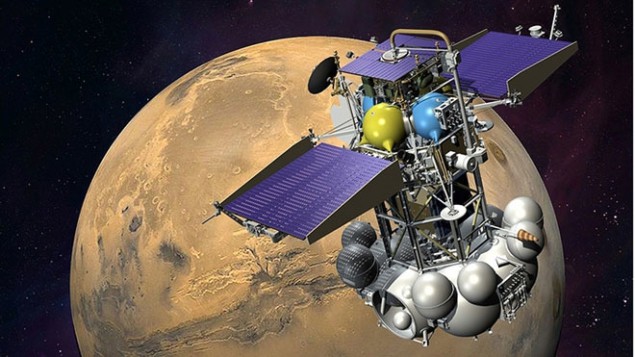
Hopes are fading that Russian technicians will be able to fire the engines of the Phobos-Grunt spacecraft, which is currently stuck in Earth orbit. Launched last week, Phobos-Grunt was designed to travel to Mars’ moon Phobos and return up to 200 g of its soil to Earth in a three-year trip. However, the spacecraft’s engines failed to fire once it separated from the launch rocket.
Since then, technicians from Russia’s Roscosmos space agency have being trying to establish contact with the spacecraft in an attempt to fire the engines and send it on its way. However, Phobos-Grunt is currently about 200 km above us in a rapidly decaying orbit – and could plummet to Earth before the New Year.
According to the Russian news agency RIA Novosti, mission scientists say that they have until early December to recover the mission. However, because the spacecraft is not designed to operate in such an orbit, communication is proving difficult. Also, it is possible that Phobos-Grunt’s batteries died before its solar panels deployed, leaving it powerless.
Two-hour warning
NASA satellite expert Nicholas Johnson of the Johnson Space Center in Texas told physicsworld.com that the spacecraft is “anticipated to fall back to Earth in late December”, with the exact time depending on “both the level of solar activity and the attitude/stability of the spacecraft”. He adds that NASA would be able to give only a two-hour warning prior to re-entry with an uncertainty of about 25 minutes either way, thus making it difficult to predict exactly where any debris would land.
Indeed, it is uncertain if the spacecraft will break-up completely during re-entry, or if larger pieces will fall to Earth. “We cannot predict what components might survive re-entry since we do not have sufficient engineering details on Phobos-Grunt,” says Johnson, alluding to a lack of information emerging from Roscosmos about the mission.
In particular, there is some concern about the fate of several tonnes of fuel aboard Phobos-Grunt. Johnson told physicsworld.com that the fuel could reach Earth intact if it is encased in tanks made of a material, such as titanium, with a high melting temperature. However, he believes that aluminium tanks would melt during re-entry, dispersing the fuel. RIA Novosti has reported that the tanks are indeed made of aluminium.
Chinese probe
Phobos-Grunt (which means Phobos-soil) was launched on Tuesday 8 November from the Baikonur launch pad in Kazakhstan on a Zenit-2SB rocket. The craft initially took off successfully and separated from its Zenit launch vehicle, but its own propulsion system then failed and the craft began to veer off course.
Costing a total of $163m, the mission was also carrying a Chinese-built probe called Yinghuo-1. The plan was that the probe would separate from Phobos-Grunt to orbit Mars for 12 months to study the planet’s atmosphere. With a mass of 115 kg, Yinghuo-1 was the first Chinese probe intended for another planet.



